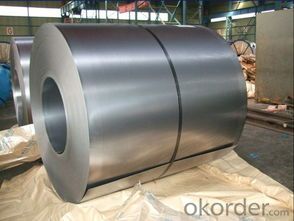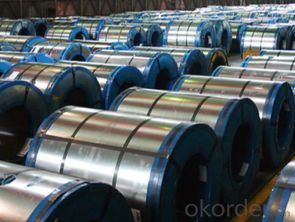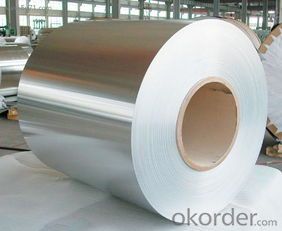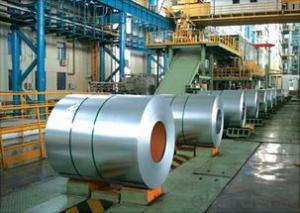Cold Rolled Steel Coil for the Building JIS G 3302
- Loading Port:
- China main port
- Payment Terms:
- TT OR LC
- Min Order Qty:
- 50 m.t.
- Supply Capability:
- 10000 m.t./month
OKorder Service Pledge
OKorder Financial Service
You Might Also Like
Cold Rolled Steel Coil for the Building JIS G 3302
1.Structure of Cold Rolled Steel Description:
The raw material of cold rolled steel coil/sheet is high quality hot rolled product, and after pickling continuous rolling, degreasing, annealing,skin pass,slitting and cut to length line etc. Along with it many kinds of new technology and new process of global cold rolling production have been applied. Therefore the quality of the goods could be guaranteed. The product is widely used in outdoor and interior decoration, furnishing manufacturing, home appliance, automobile etc.
2.Main Features of the Cold Rolled Steel:
• Excellent process capability
• Smooth and flat surface
• Workability, durability
• Excellent heat resistance performance
• High strength
• Good formability
• Good visual effect
3.Cold Rolled Steel Images



4.Cold Rolled Steel Specification
Standard:AISI,ASTM,DIN,GB,JIS,JIS G3302 ASTM 653M EN10142
Grade: Q195~Q345
Thickness: 0.16mm~2.0mm
Width: 1250mm MAX
Coil weight:3-12 MT
Coil ID:508/610mm
Chemical composition:
C | Si | Mn | Cr | Ni | P | S |
0.150 | 0.476 | 11.231 | 12.50 | 0.900 | 0.039 | 0.010
|
5.FAQ of Cold Rolled Steel
We have organized several common questions for our clients,may help you sincerely:
1.How about your company?
A world class manufacturer & supplier of castings forging in carbon steel and alloy steel,is one of the large-scale professional investment casting production bases in China,consisting of both casting foundry forging and machining factory. Annually more than 8000 tons Precision casting and forging parts are exported to markets in Europe,America and Japan. OEM casting and forging service available according to customer’s requirements.
2.How to guarantee the quality of the products?
We have established the international advanced quality management system,every link from raw material to final product we have strict quality test;We resolutely put an end to unqualified products flowing into the market. At the same time, we will provide necessary follow-up service assurance.
3. How long can we receive the product after purchase?
Usually within thirty working days after receiving buyer’s advance payment or LC. We will arrange the factory manufacturing as soon as possible. The cargo readiness usually takes 15-25 days, but the shipment will depend on the vessel situation.
- Q:What are the common handling defects in steel coils?
- There are several common handling defects that can occur in steel coils during transportation and storage. These defects can impact the quality and integrity of the coils, leading to potential issues down the line. Some of the most common handling defects in steel coils include: 1. Edge damage: This occurs when the edges of the coil are bumped or scraped, resulting in dents, scratches, or even tears. Edge damage can weaken the structural integrity of the coil and make it more susceptible to further damage. 2. Core damage: The core of a steel coil is crucial for maintaining its shape and stability. However, mishandling can cause the core to become crushed or deformed, which can lead to coil collapse or distortion. 3. Coil slippage: When coils are not securely strapped or stacked, they can shift or slide during transportation. This can result in coil slippage, leading to misalignment, damage to the outer layers, or even complete coil failure. 4. Abrasion: Steel coils can be subject to abrasion if they come into contact with rough surfaces or other objects during handling. This can cause the protective coating or paint on the coil to wear off, exposing the steel to potential corrosion. 5. Moisture damage: Steel coils are susceptible to moisture damage, especially if they are not properly sealed or protected. Exposure to moisture can lead to rust formation, which can compromise the structural integrity of the coil and affect its overall quality. 6. Overloading: Overloading a truck or storage area with steel coils can cause excessive pressure and stress on the coils, leading to deformation, bending, or even coil collapse. It is crucial to adhere to weight limits and proper stacking procedures to prevent overloading. 7. Improper lifting: When lifting steel coils, it is important to use appropriate lifting equipment and techniques. Failure to do so can result in coil damage, such as distortion or bending, as well as potential injuries to workers. To mitigate these handling defects, it is crucial to follow proper handling and storage procedures for steel coils. This includes using suitable lifting equipment, securing the coils during transportation, avoiding overloading, and ensuring proper protection against moisture and abrasion. Regular inspections and maintenance can also help identify and address any potential defects or issues before they worsen.
- Q:How are steel coils used in the production of automotive structures?
- Various methods involve the usage of steel coils in the production of automotive structures. To begin with, these coils serve as the primary material for manufacturing car bodies and frames. Typically composed of high-strength steel, known for its durability and crashworthiness, these coils undergo processing and forming to create different automotive components such as panels, doors, roofs, and pillars. Moreover, steel coils are also utilized in the creation of various structural components within an automobile. For instance, they contribute to the fabrication of suspension systems, chassis, and other vital parts that provide stability, strength, and support to the vehicle. Steel coils frequently find application in the production of structural beams, reinforcement bars, and other load-bearing elements that ensure the overall strength and safety of the vehicle. Furthermore, steel coils play a significant role in the manufacturing of automotive parts that require precise shaping and forming processes. These coils are fed into stamping presses, where they undergo a series of operations including cutting, bending, and shaping to produce intricate parts such as brackets. The versatility of steel enables the production of complex automotive structures with exceptional accuracy and precision. Additionally, steel coils are crucial in the production of automotive exhaust systems. Typically composed of stainless steel, which exhibits excellent resistance to corrosion and high temperatures, these coils are formed and welded into exhaust pipes, mufflers, and catalytic converters, guaranteeing the durability and longevity of these critical components. In conclusion, the utilization of steel coils is essential in the production of automotive structures. They are employed in the creation of car bodies, frames, suspension systems, chassis, and other structural components. Steel coils also play a vital role in the manufacturing of precise and intricate automotive parts, as well as exhaust systems. Overall, the presence of steel coils contributes significantly to the strength, safety, and longevity of automotive structures.
- Q:How are steel coils used in the manufacturing of lighting fixtures?
- Steel coils are commonly used in the manufacturing of lighting fixtures as they provide a sturdy and durable framework for the fixtures. The coils are often shaped and welded to create the desired structure, ensuring that the lighting fixtures are robust and can withstand various installation environments. Additionally, steel coils can be coated or painted to enhance the aesthetics of the fixtures, making them more visually appealing.
- Q:does anyone out there know where to get a good deal on a pedal steel guitar? i am from northern indiana and i'm willing to travel some if i have to.i am just getting into pedal steel guitar and i really don't have any idea what i need. i don't know how to play a guitar (i do know how to play the piano and the drums) at all but i want to learn to play the pedal stell guitar and i can't do that without getting one first so, if anyone can help me out i would greatly appreciate it! :o)
- Pedal steel guitars are a challenge to learn but they're a great instrument. More, even a starter pedal steel is going to run you $800 or so. Elderly Instruments in Lansing, Michigan sells a Carter brand starter pedal steel for $795 which is about as low as I've seen new ones. It has 3 foot pedals and 4 knee levers so it's nicely equipped. From northern Indiana it's not that far I would think. Good luck.
- Q:I saw this really pretty ring online and it was made of steel. Is this a good ring? If I were to wash my hands with it on, would it rust and turn my finger green?
- Steel rust is brown not green! Very much expected to be of one type of stainless steel, and you should have no problem.
- Q:How do steel coil manufacturers contribute to local economies?
- Steel coil manufacturers contribute to local economies in several ways: 1. Job creation: Steel coil manufacturing facilities require a significant workforce to operate, including skilled workers, engineers, technicians, and support staff. By establishing and expanding manufacturing plants, steel coil manufacturers create employment opportunities for local residents. This leads to reduced unemployment rates and increased income levels, which in turn stimulates local spending and economic growth. 2. Supplier networks: Steel coil manufacturers rely on a wide range of suppliers for raw materials, equipment, and services. This creates a network of local businesses that benefit from the demand generated by manufacturing operations. These suppliers include steel producers, logistics companies, packaging providers, maintenance service providers, and many others. The presence of a steel coil manufacturer can stimulate the growth and development of these local businesses, enhancing the overall economic vitality of the region. 3. Secondary industries: The steel coil manufacturing industry acts as a catalyst for the development of secondary industries. These industries include steel fabrication, construction, automotive manufacturing, machinery production, and many others that rely on steel as a primary input. The presence of a steel coil manufacturer in a local economy can attract and support the growth of these industries, leading to increased economic activity and job opportunities. 4. Tax revenue: Steel coil manufacturers contribute to the local economy through the payment of various taxes. These include corporate income taxes, property taxes, sales taxes, and employment taxes. The tax revenue generated by these manufacturers is often significant and can be used by local governments to fund public infrastructure projects, education, healthcare services, and other essential services that benefit the community. 5. Economic multiplier effect: The economic impact of steel coil manufacturers extends beyond their direct operations. The presence of these manufacturers attracts other businesses and industries to the region, leading to a multiplier effect. For example, steel distributors, fabricators, and processors may establish operations nearby to take advantage of the proximity to the manufacturer. This creates a cluster of related industries that further contribute to the local economy, creating a self-sustaining cycle of economic growth and development. In summary, steel coil manufacturers contribute to local economies by creating jobs, supporting local suppliers, stimulating secondary industries, generating tax revenue, and triggering an economic multiplier effect. Their presence enhances the economic vitality of the region, leading to increased employment opportunities, income levels, and overall economic growth.
- Q:I am planning to buy a Walther P22. I have liked the Pistol's performance-superb.The only confusion that I have is about the Polymer Frame.Just for this I may shift to someother manufacturer.Are Polymer Frames better than Steel in durability and lifespan.Walther says YES.Any comments on this...Practical users...Thanks in advance
- On okorder under the Walther section. I know the P22 will hold up well with normal maintenance for 5000 rounds. I can't tell you from practical experience if it will still be great at 10000 since mine hasn't gotten that far yet.
- Q:How are steel coils used in the production of railway tracks?
- Steel coils are a crucial component in the production of railway tracks. These coils are typically made of high-quality steel and are used to manufacture the rails that form the foundation of the tracks. The process begins with the steel coils being unwound and fed through a series of machines that shape and form them into the desired rail profile. The steel coils are first passed through a rolling mill, where they are gradually flattened and shaped into long strips of steel. This process is known as hot rolling, as the steel is heated to high temperatures to make it more malleable. The rolling mill applies immense pressure to the steel, gradually transforming it into the desired rail shape. Once the steel coils have been rolled into the required shape, they are then cut into individual rail lengths. These lengths can vary depending on the specifications of the railway track being produced. The rail lengths are then further processed to remove any imperfections and straighten them out. After this initial shaping and processing, the rails are subjected to a series of additional treatments. These treatments may include heat treatment to enhance their strength and durability, as well as various surface treatments to prevent corrosion and wear. Once the rails have undergone all the necessary treatments, they are ready to be installed on the railway track. They are laid out in a carefully planned pattern, with each rail securely fastened to the sleepers or ties. The continuous length of steel provided by the coils ensures a seamless and uniform track, allowing trains to travel smoothly and safely. In summary, steel coils play a vital role in the production of railway tracks. They are used to manufacture the rails that form the foundation of the tracks, ensuring durability, strength, and a smooth surface for trains to run on. The use of high-quality steel coils in this process is essential to ensure the safety and efficiency of railway transportation.
- Q:i currently have just steel guitar strings, not a fan they need replacing and i was wondering whats the difference between steel and bronze strings and or nickle strings?
- Not all strings have a steel core. There are different substances used for the core on metal guitar strings (not even mentioning nylons), but the market is predominated by a steel core. The tonal properties of what steel strings are wound up by can make a great difference to the overall sound of an instrument. In general, nickel strings are bright but give off well-rounded frequencies and have properties that make them perfect for use with magnetic pickups, such as those used in electric guitars. Bronze-wound strings are a little mellower in timbre but give off more high-low (harmonically rich) frequencies and are favorites on acoustic steel-string guitars. Silk and steel-wound guitar strings are the mellowest sounding and give off more low-mid frequencies than the others. They are generally used for folky types of acoustic playing where little attack is needed. There are others but I won't mention them because you won't find them easily. There are other factors and merits of each type of string like how long they last - Nickel resists corrosion the most; bronze less so; bare steel oxidizes very easily. There is also the way the string is wound to take into account (flat-wound, etc. like the other answerer mentioned).
- Q:How are steel coils used in the production of pressure vessels?
- Steel coils are used in the production of pressure vessels as they are rolled into cylindrical shapes, which serve as the main structural component of the vessel. The coils are formed and welded together to create a strong and durable container capable of withstanding high pressures.
1. Manufacturer Overview |
|
|---|---|
| Location | |
| Year Established | |
| Annual Output Value | |
| Main Markets | |
| Company Certifications | |
2. Manufacturer Certificates |
|
|---|---|
| a) Certification Name | |
| Range | |
| Reference | |
| Validity Period | |
3. Manufacturer Capability |
|
|---|---|
| a)Trade Capacity | |
| Nearest Port | |
| Export Percentage | |
| No.of Employees in Trade Department | |
| Language Spoken: | |
| b)Factory Information | |
| Factory Size: | |
| No. of Production Lines | |
| Contract Manufacturing | |
| Product Price Range | |
Send your message to us
Cold Rolled Steel Coil for the Building JIS G 3302
- Loading Port:
- China main port
- Payment Terms:
- TT OR LC
- Min Order Qty:
- 50 m.t.
- Supply Capability:
- 10000 m.t./month
OKorder Service Pledge
OKorder Financial Service
Similar products
New products
Hot products
Related keywords





























